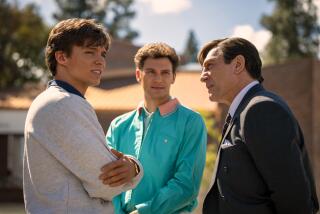Static but Not Stagnant
Still-life painting doesn’t have a particularly glamorous mystique. As an artistic act it seems born of desperation. As a finished product it recommends itself to people who want their art to be inoffensive. Such an unpromising first impression isn’t helped by the fact that in French the genre is called nature morte--literally “dead nature.”
These stereotypes are put to the test in a traveling exhibition visiting the Orange County Museum of Art. “Still Life: The Object in American Art, 1915-1995, Selections from the Metropolitan Museum of Art” was chosen by Metropolitan curator Lowery Stokes Sims and her associate Sabine Rewald.
The whole may appear as the announcement of a new reserve on the part of the Orange County Museum of Art, a museum known for trendiness in its former incarnation as the Newport Harbor Art Museum.
Publicity for the show trumpets the opportunity to see 60 modern works from one of the world’s great museums. Forgetting for the moment that the Met’s renown doesn’t rest on its holdings in recent art, the catalog reminds us that they haven’t even put their best modern still life examples on the road.
Such icons as Marsden Hartley’s “Portrait of a German Officer” and Charles Demuth’s “The Figure 5 in Gold” are reproduced but not included. The closest thing to a textbook masterpiece here is Stuart Davis’ little 1924 proto-Pop “Edison Mazda.”
None of this kvetching, however, intends to condemn this as a bad show. It is rather--sometimes annoyingly but more often enticingly--offbeat, full of quirky juxtapositions, half-forgotten artists and works that don’t conform to conventional notions of still life at all.
The most disorienting bit is in the show’s organization. Such reasonable-sounding pigeonholes as “Table Still Life,” “Flower Paintings” and “The Iconic Object” get the genres right, but muddle style and chronology. Thus a Cubist-style 1921 “Sunflowers” by E. McKnight Kauffer finds itself in the company of a 1945 neo-Impressionist “White Roses” by Franklin Watkins. Folk styles are next to Surrealism, and unruly Abstract Expressionism gets neighborly with prim Photorealism.
The effects of such a swap-meet smorgasbord presentation are piquant, but they do tend to distract from the two great virtues that make still life artistically indispensable. Its principal formal strength is that it allows serious investigation of compositional structure with a minimum of fuss and an abundance of neutral objects to paint.
After all, the very foundations of Modernist painting were laid by Paul Cezanne, who concentrated on still life. The exhibition abounds with examples of this sort of art-for-its-own-sake.
They range from Fairfield Porter’s melding of image and paint to, say, Jim Dine, who reduces imagery to a motif for the dramatization of the direct act of painting. Andy Warhol reversed the formula in the image of a hammer and sickle neutralizing substance so that meaning resides in the symbolic vectors of the object.
Some of the exhibition’s most compelling works are those that come to grips with still life’s inherent problem of making inanimate objects eloquent. A wonderful example is James Valerio’s “Still Life With Decoy.”
Its centerpiece looks like a woman’s vanity table. Combined objects suggest a sincere love wrecked at the last minute by the discovery of a false element. Yet the scenario remains enigmatic, particularly because the table is set in the midst of an artist’s studio. This carries the further suggestion that all visible reality is a decoy distracting us from a more authentic, invisible reality.
The most richly complex works here are several that pursue this idea of still-life-as-metaphysic. Paul Wonner plays with the whole notion of symbolism. “Dutch Still Life With Orchids, Postcard View of Paris and Death of Marat” composes all these objects as distinctly separate things. Although painted to appear very solid, they take on the character of separate words lettered on bits of paper and laid out in random order. We can make of them what we will.
Mark Tansey’s “Still Life” is a brownish monochrome showing a room with an easel holding a canvas that bears the image of a bouquet in a vase. Nearby, a woman empties flowers from a container into the trash. The viewer is inclined to think, “Oh, she’s throwing the real flowers away.” Then you get your wits about you and realize that the “real” flowers are just as much an illusion as the rest of the painting. This is art about being literally disillusioned with art.
* Orange County Museum of Art, 850 San Clemente Drive, Newport Beach. 11 a.m.-5 p.m. Tuesday-Sunday. $4-$5, children under 16 free. Through Aug. 17. (714) 759-1122.
More to Read
The biggest entertainment stories
Get our big stories about Hollywood, film, television, music, arts, culture and more right in your inbox as soon as they publish.
You may occasionally receive promotional content from the Los Angeles Times.










